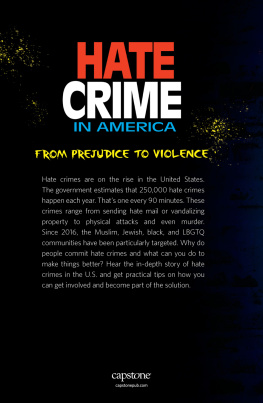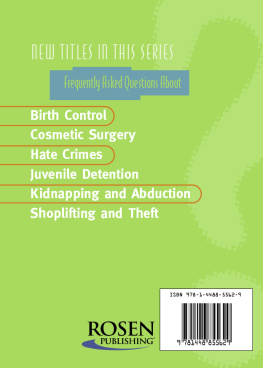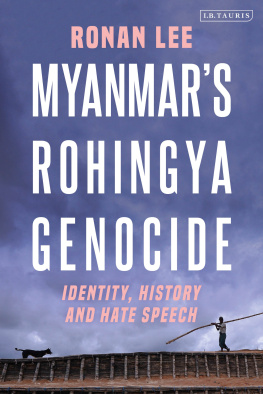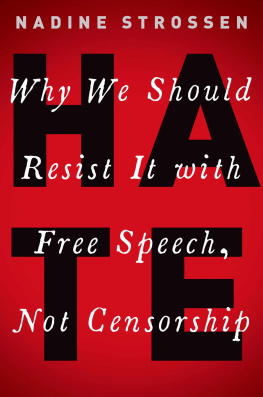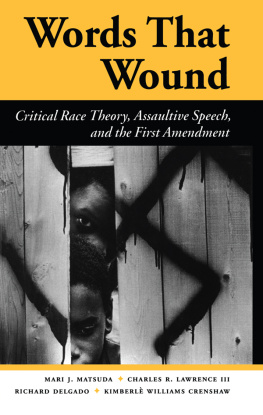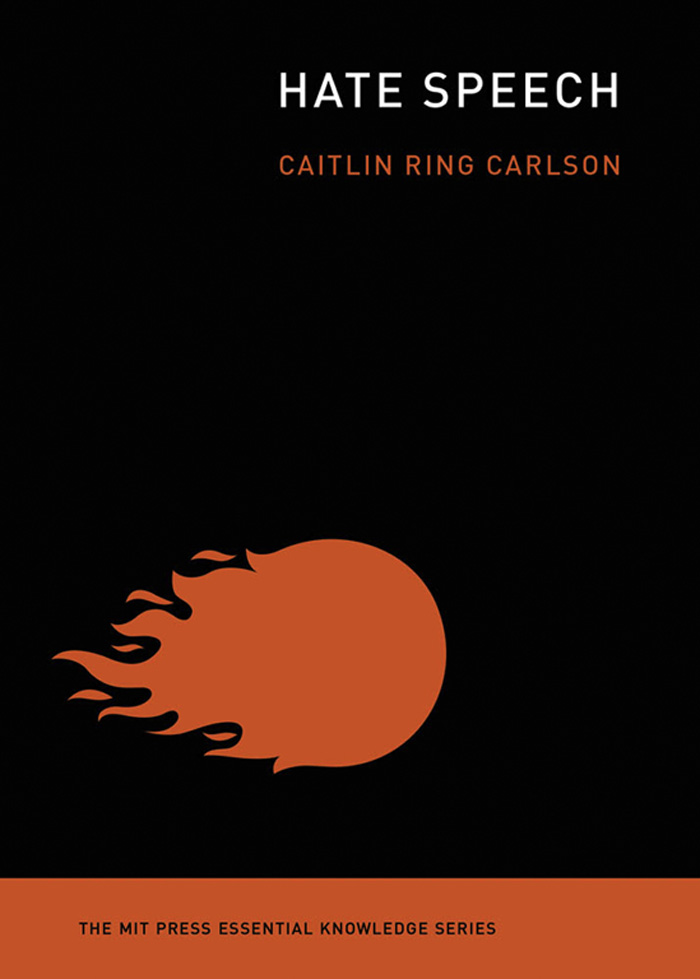
Hate Speech
The MIT Press Essential Knowledge Series
A complete list of the titles in this series appears at the back of this book.
Hate Speech
Caitlin Ring Carlson
The MIT Press | Cambridge, Massachusetts | London, England
2021 Massachusetts Institute of Technology
All rights reserved. No part of this book may be reproduced in any form by any electronic or mechanical means (including photocopying, recording, or information storage and retrieval) without permission in writing from the publisher.
This book was set in Chaparral Pro by New Best-set Typesetters Ltd.
Library of Congress Cataloging-in-Publication Data
Names: Carlson, Caitlin Ring, author.
Title: Hate speech / Caitlin Ring Carlson.
Description: Cambridge, Massachusetts The MIT Press, 2021. | Series: The MIT Press essential knowledge series | Includes bibliographical references and index.
Identifiers: LCCN 2020004631 | ISBN 9780262539906 (paperback)
Subjects: LCSH: Hate speechLaw and legislation. | Hate speechLaw and legislationUnited States. | Hate speech. | Hate speechUnited States.
Classification: LCC K5210 .C37 2021 | DDC 342.08/53dc23
LC record available at https://lccn.loc.gov/2020004631
10 9 8 7 6 5 4 3 2 1
d_r0
Contents
Series Foreword
The MIT Press Essential Knowledge series offers accessible, concise, beautifully produced pocket-size books on topics of current interest. Written by leading thinkers, the books in this series deliver expert overviews of subjects that range from the cultural and the historical to the scientific and the technical.
In todays era of instant information gratification, we have ready access to opinions, rationalizations, and superficial descriptions. Much harder to come by is the foundational knowledge that informs a principled understanding of the world. Essential Knowledge books fill that need. Synthesizing specialized subject matter for nonspecialists and engaging critical topics through fundamentals, each of these compact volumes offers readers a point of access to complex ideas.
1
Introduction
In Virginia, young men in khaki pants and white polo shirts march through the center of a public university campus, shouting Jews will not replace us. In the Tsuruhashi district of Osaka, Japan, a 14-year-old girl addresses the crowd, saying how much she despises Korean people and wishes she could kill them all. In Myanmar, a Facebook user publishes a post to his page about Bengalis, calling them dogs who are destroying his land and his people. In Cape Town, a pastor makes a comment online asking ISIS to please come rid South Africa of the homosexual curse.
Unfortunately, no culture, country, or form of communication is immune from the existence or influence of hate speech. Whether online or in person, people wield language as a weapon to attack one anothers identities, reaffirming their own perceived position of dominance and solidifying their feelings of belonging to a given social group. The impact of this expression is detrimental, both to the individuals targeted and to the societies that condone its use. Hate speech traumatizes its victims and negatively impacts their self-worth; it silences political participation and distorts public discourse. Hate speech can also be used as a tool to dehumanize groups, normalizing violence against them by amplifying egregious claims through mass media. Despite the problems it causes, cultural and political policy makers continue to struggle with regulating hate speech.
Defining Hate Speech
No culture, country, or form of communication is immune from the existence or influence of hate speech.
Hate speech is an expansive and contested term. Part of what is so challenging about this issue is the fact that scholars dont agree on what hate speech is, or is not. The Anti-Defamation Leagues former national director, Abraham H. Foxman, and attorney Christopher Wolf argue that hate speech includes broad categories of speech, including racism, anti-Semitism, homophobia, bigotry against the disabled, political hatred, rumormongering, misogyny and violent pornography, promotion of terrorism, cyberbullying, harassment, stalking, and the sale and promotion of online products. Broadly, hate speech should be defined as expression that seeks to malign an individual for their immutable characteristics, such as their race, ethnicity, national origin, religion, gender, gender identity, sexual orientation, age, or disability. I use the term expression because hate speech includes not only spoken words, but also symbols and images that degrade people for the qualities theyre born with.
Each conception of hate speech presented here talks about it as being a form of expression that degrades a person based on their fixed characteristics. However, after reading Kate Mannes Down Girl, I consider hate speech to be a structural issue. In her book, Manne reconceptualizes the definition of misogyny. Rather than a deep-seated hatred of women by men, as many long thought, misogyny is recast as a structural phenomenon that works to control, police, and punish women who subvert the existing system of male dominance. For example, when Hillary Clinton received the Democratic Partys nomination for President of the United States in 2016, supporters of her opponent, Donald Trump, shouted Lock the bitch up at his political rallies. At the Republican National Convention, vendors sold T-shirts that read Trump that bitch and If you can read this, the bitch fell off. Like a game of whack-a-mole, misogyny works to hammer down women who threaten mens social, economic, or political dominance.
Like Mannes definition of misogyny, hate speech represents a structural phenomenon in which those in power use verbal assaults and offensive imagery to maintain their preferred position in the existing social order. In the United States, White people have long used the N-word or called an African American man boy to reinforce White supremacy. In Japan, an extremist organization, Zaitokukai, believes Zainichi Koreans have unearned, special privileges in Japanese society. Terms like cockroaches and criminals are used to diminish the humanity of Zainichi Koreans and the Zaitokukai openly call for their massacre. By putting others down, the Zaitokukai expose themselves as a threatened class attempting to maintain their position of dominance in the social structure.
Hate speech represents a structural phenomenon in which those in power use verbal assaults and offensive imagery to maintain their preferred position in the existing social order.
In addition to clarifying what hate speech is, it is also important to understand what it is not. Hate speech is not synonymous with offensive speech. Words or images that someone finds upsetting or hurtful do not meet legal or even colloquial definitions of hate speech. Saying that you dont like someone, their personality or their politics, does not constitute hate speech. In order to be considered hate speech, expression must directly attack a persons immutable identity characteristics such as race, gender, or sexual orientation.
Hate speech also differs from hate crimes. Hate crimes are criminal acts that are motivated by prejudice against a victim or victims because of their immutable characteristics, such as their race, religion, or ethnicity. If a criminal act is designated as a hate crime, it often carries additional penalties such as an increased prison sentence. Hate speech may be used during the commission of a hate crime but the terms are not synonymous with one another.
Next page


